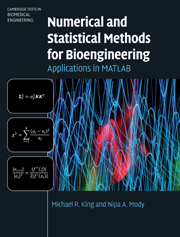Book contents
- Frontmatter
- Contents
- Preface
- 1 Types and sources of numerical error
- 2 Systems of linear equations
- 3 Probability and statistics
- 4 Hypothesis testing
- 5 Root-finding techniques for nonlinear equations
- 6 Numerical quadrature
- 7 Numerical integration of ordinary differential equations
- 8 Nonlinear model regression and optimization
- 9 Basic algorithms of bioinformatics
- Appendix A Introduction to MATLAB
- Appendix B Location of nodes for Gauss–Legendre quadrature
- Index for MATLAB commands
- Index
- References
8 - Nonlinear model regression and optimization
Published online by Cambridge University Press: 05 June 2012
- Frontmatter
- Contents
- Preface
- 1 Types and sources of numerical error
- 2 Systems of linear equations
- 3 Probability and statistics
- 4 Hypothesis testing
- 5 Root-finding techniques for nonlinear equations
- 6 Numerical quadrature
- 7 Numerical integration of ordinary differential equations
- 8 Nonlinear model regression and optimization
- 9 Basic algorithms of bioinformatics
- Appendix A Introduction to MATLAB
- Appendix B Location of nodes for Gauss–Legendre quadrature
- Index for MATLAB commands
- Index
- References
Summary
Introduction
Mathematical modeling is used to analyze and quantify physical, biological, and technological processes. You may ask, “What is modeling and what purpose does a model serve in scientific research or in industrial design?” Experimental investigation generates a set of data that describes the nature of a process. The quantitative trend in the data, which describes system behavior as a function of one or more variables, can be fitted to a mathematical function that is believed to represent adequately the relationship between the observations and the independent variables. Fitting a model to data involves determining the “best-fit” values of the parameters of the model.
A mathematical model can be of two types.
(1) A model formulated from physical laws is called a mechanistic model. A model of this type, if formulated correctly, provides insight into the nature of the process. The model parameters can represent physical, chemical, biological, or economic properties of the process.
(2) An empirical model, on the other hand, is not derived from natural laws. It is constructed to match the shape or form of the data, but it does not explain the origin of the trend. Therefore, the parameters of an empirical model do not usually correspond to physical properties of the system.
Mechanistic models of scientific processes generate new insights into the mechanisms by which the processes occur and proceed in nature or in a man-made system. A mathematical model is almost always an incomplete or imperfect description of the system.
- Type
- Chapter
- Information
- Numerical and Statistical Methods for BioengineeringApplications in MATLAB, pp. 480 - 538Publisher: Cambridge University PressPrint publication year: 2010

